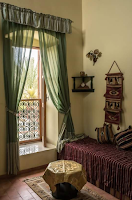The Elegance of Zimmit Hotel in Tripoli's Old City
 |
| Photo credit to Hiba Shalabi, Photographer |
It is one of the most famous hotels in the old city and it still works until this day. It is located in Bab Al-Bahar ward, specifically, in front of Marcus Arch and next to Gurgi Mosque. It was constructed by Mr. Ahmed Al-Daffairi in 1831. He was considered one of the well-known businessmen at that time. In the colonial period by the Italians, the ownership was transferred to Mr. Zimmit, the general writer for Mr. Ahmed Al-Daffairi and this is how the hotel got its current name. Since it was constructed, it was mainly used for hosting travelers and businessmen.
The hotel has a giant frontage that is similar to that of Bin Zikri Hotel. The front has a big wooden door. There is a marble board by the outer door that has welcoming words for the coming guests. Also, it was used for storing goods that came from Sudan, for example, ostrich feathers and leather and dates, etc. At some point, the hotel was rented to an anonymous Jewish man whom he turned it into storage to collect pigeons and Henna to sell them. The hotel was also used by a Libyan Band that was created by Jabir Tikbali and a number of young Libyans (Lamin Gniwa, Mohamed Abd Arrahman Gniwa, Alhassairi, and A;-Na'agi). They used to perform in it from 1958 until 1988. After that, it was used by Libyan fishermen.
To conclude, hotels are considered important economic and historical landmarks. Each hotel represents an architectural pattern that reflects the historical period it was built in. these hotels were used economically to store goods from many locations. From the social aspect, the hotel managed to connect people of the same country with each other and Tripoli’s businessmen, also, with people from neighboring countries. In this connecting method has helped introduce and accept many different cultures and traditions. Let's not forget the architectural beauty that expresses the elegance and class even if some have disappeared now but the small details can show how beautiful they were in that time.
Photo Credits go to Hiba Shalabi, a Libyan Photographer and Artist.
Photo Credits go to Hiba Shalabi, a Libyan Photographer and Artist.





Every place, corner, alleys and buildings of the amazing Tripoli old city are just breathtaking. Visiting it is like stepping back in time. Theres another place I'd love to spend a night in is where Lilla Haloma waitnessed the killing of her son by his brother. I think it's Karamanli family'shouse. Thanks for sharing this simple rich article which again fills with lots of good new info at least to me, well done!!
ReplyDeleteThank you so much for the comment :) I am glad you like the article. The old city is breath taking and it is beautiful.
Delete